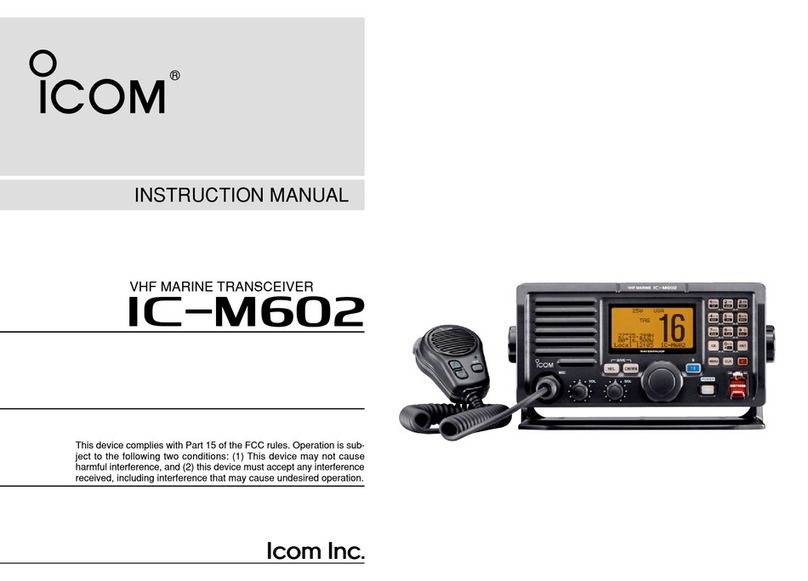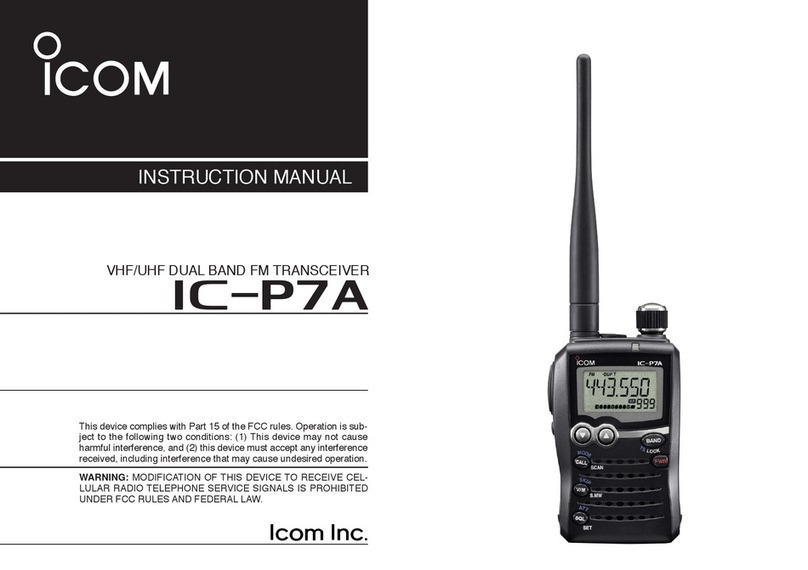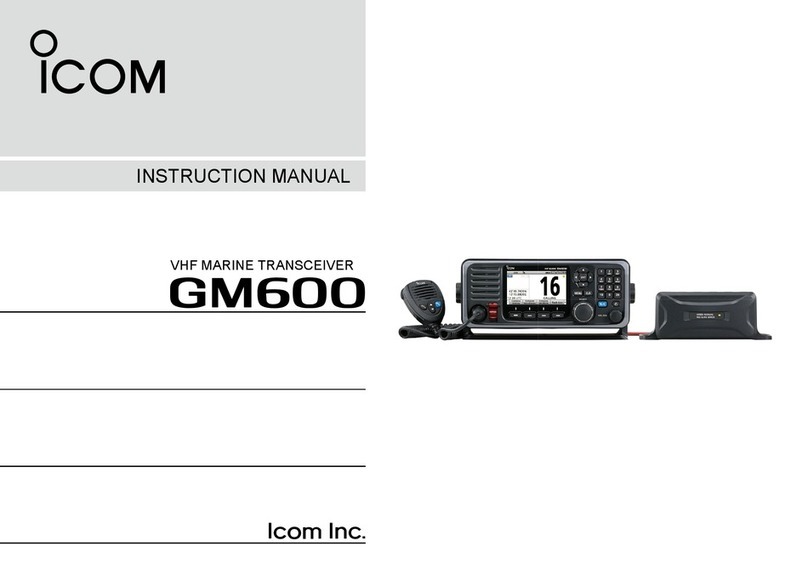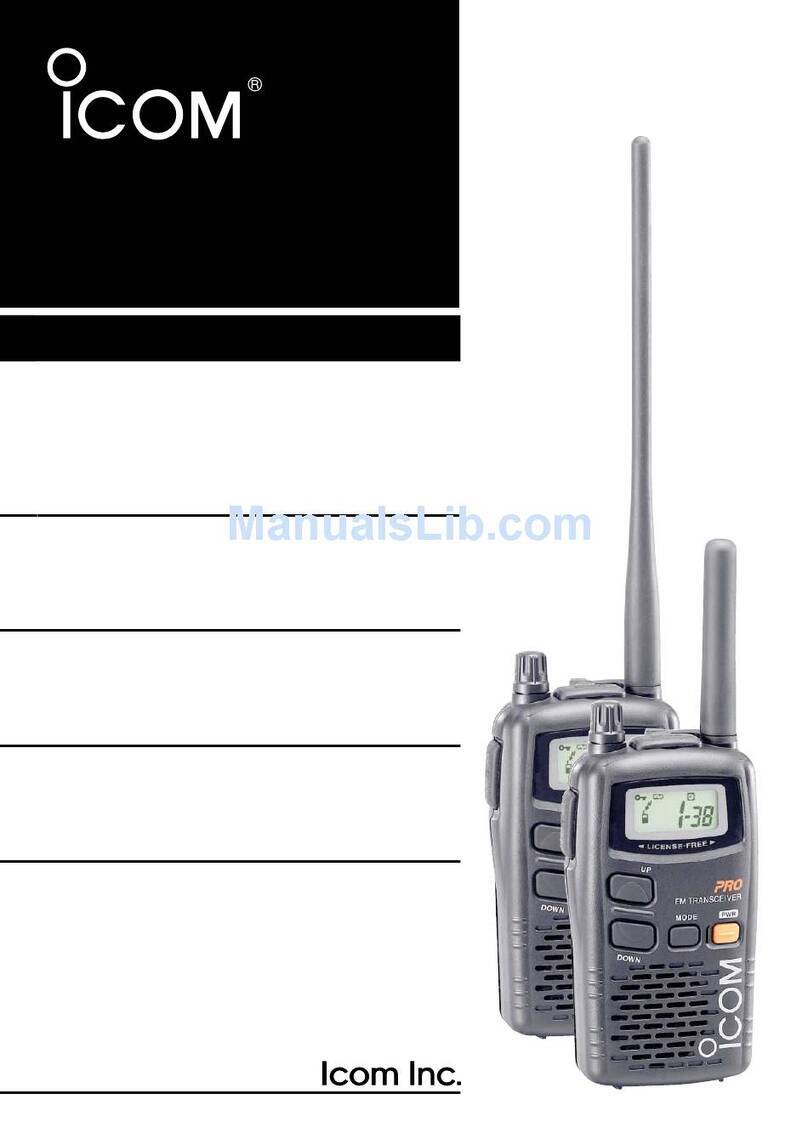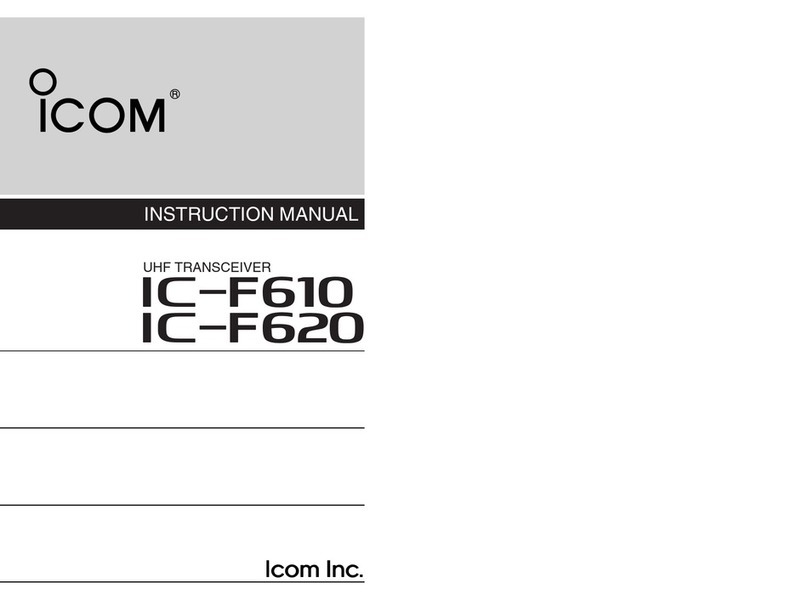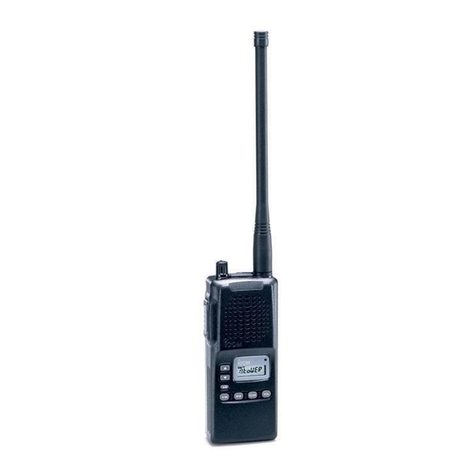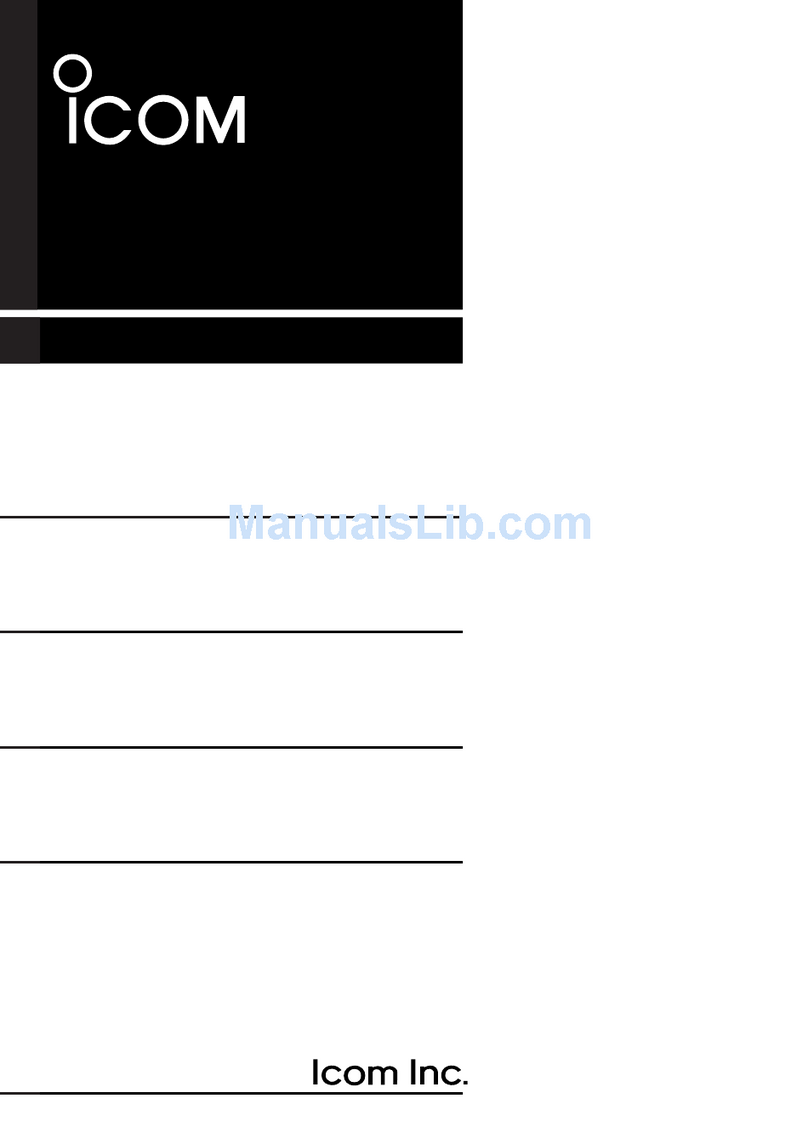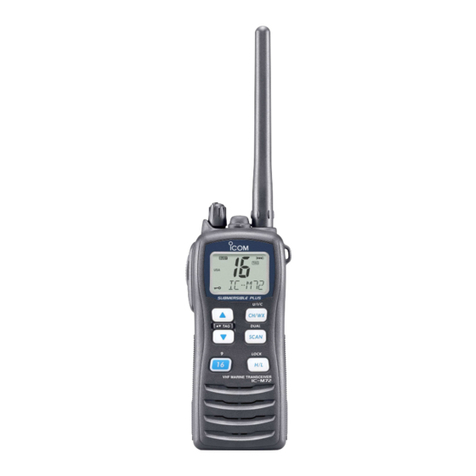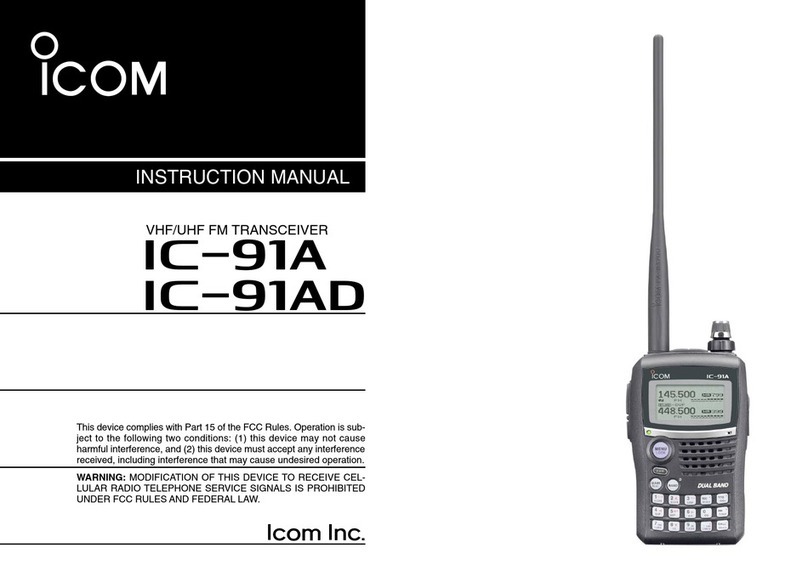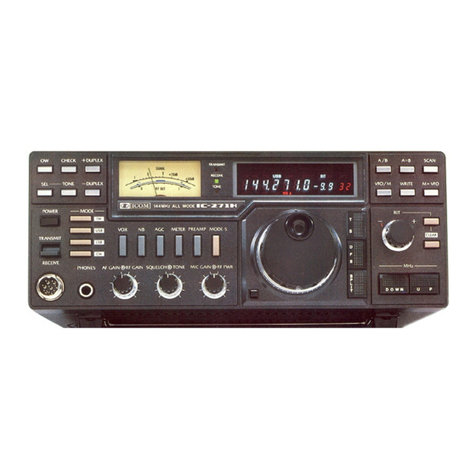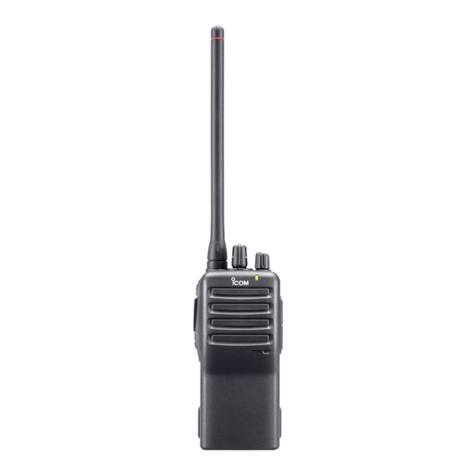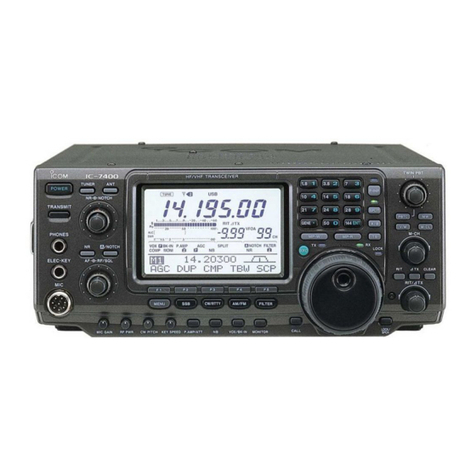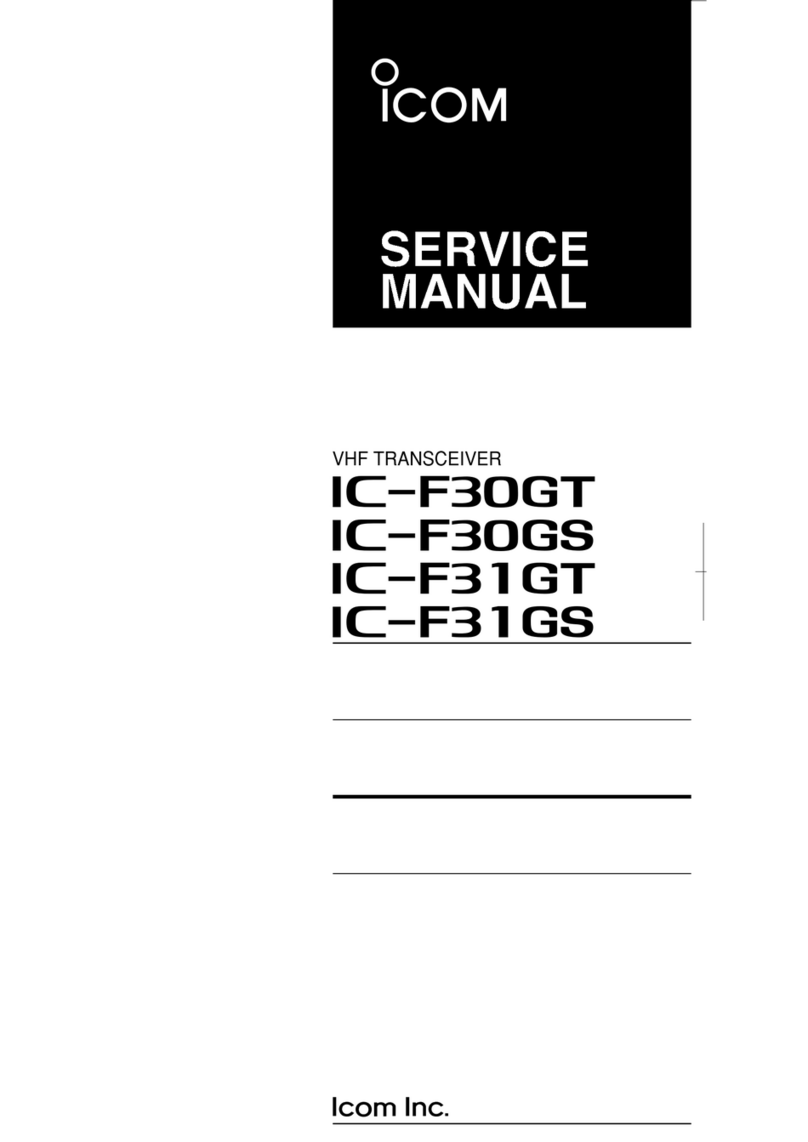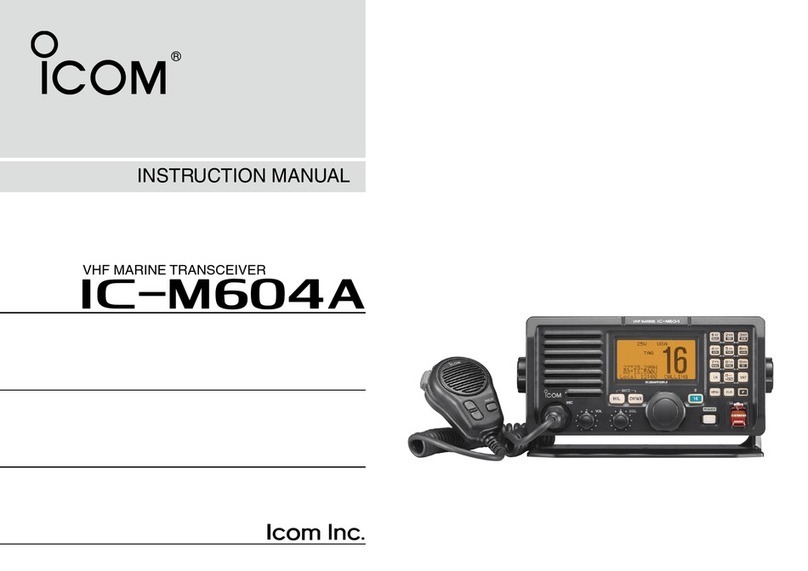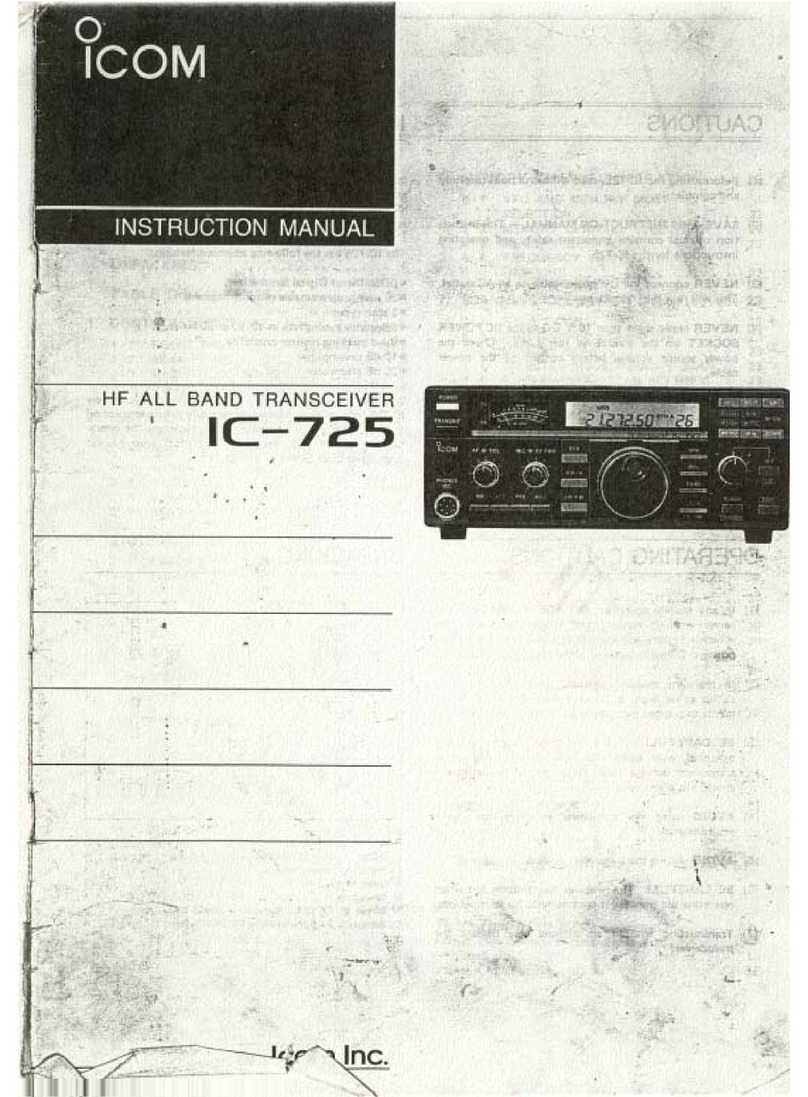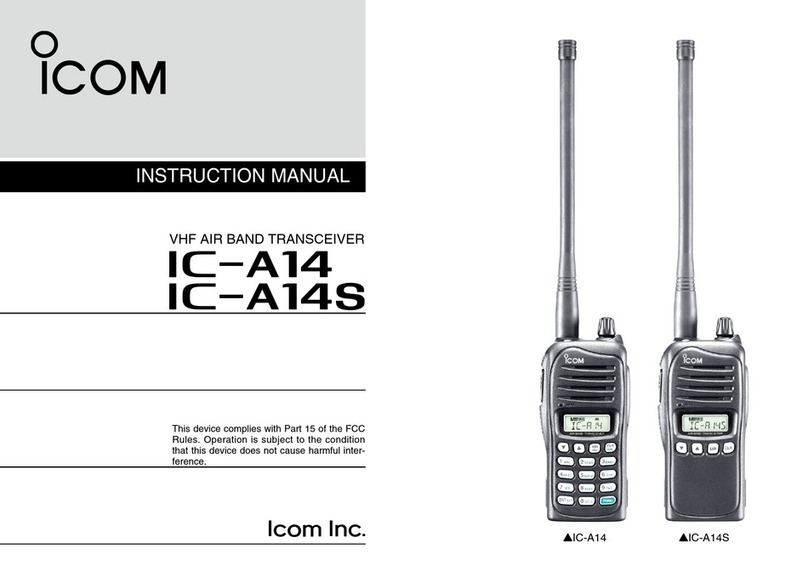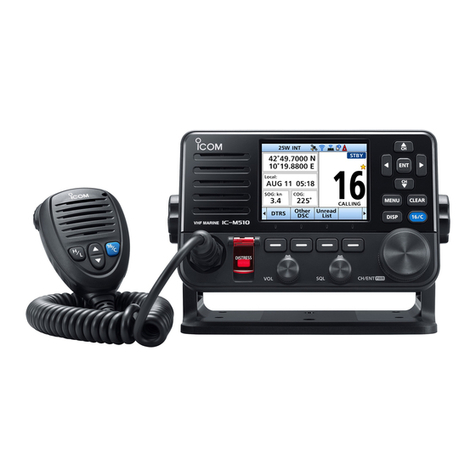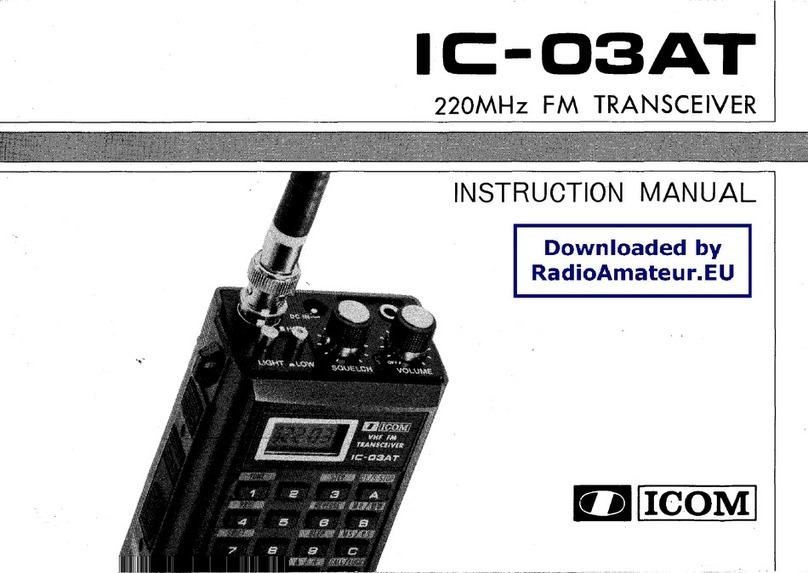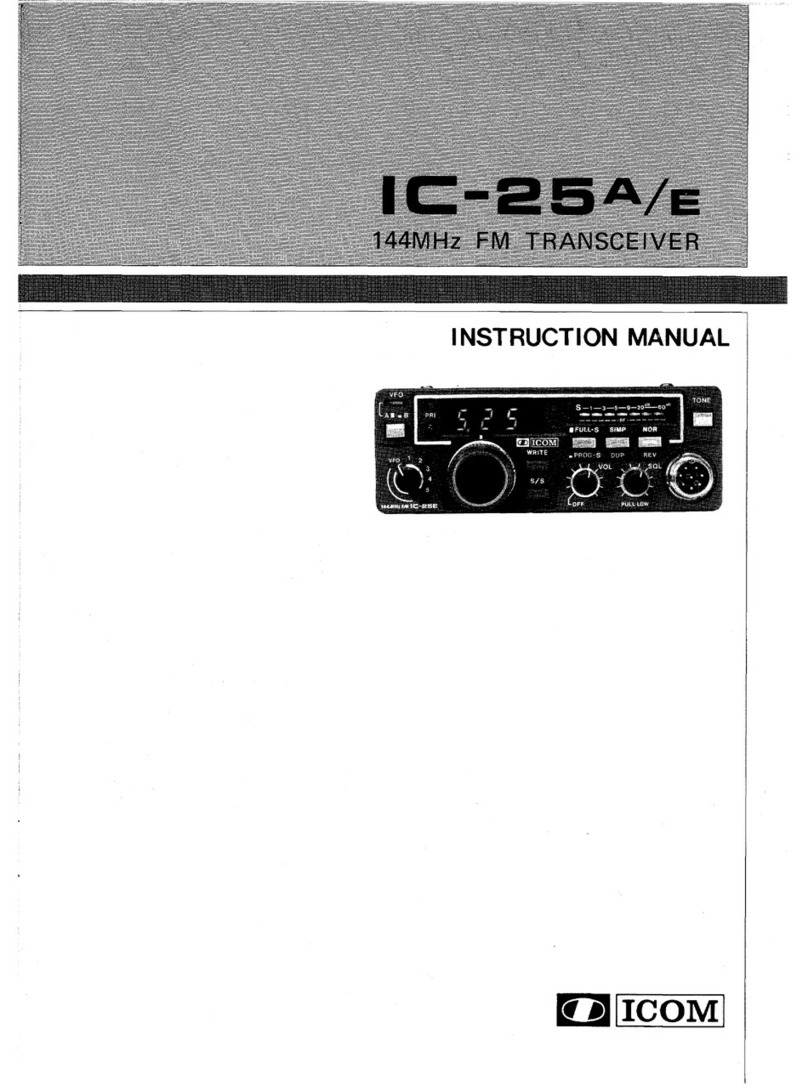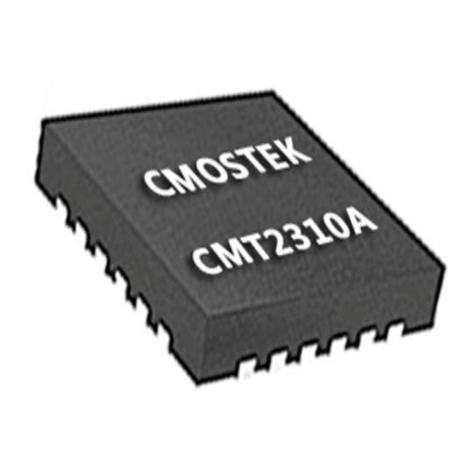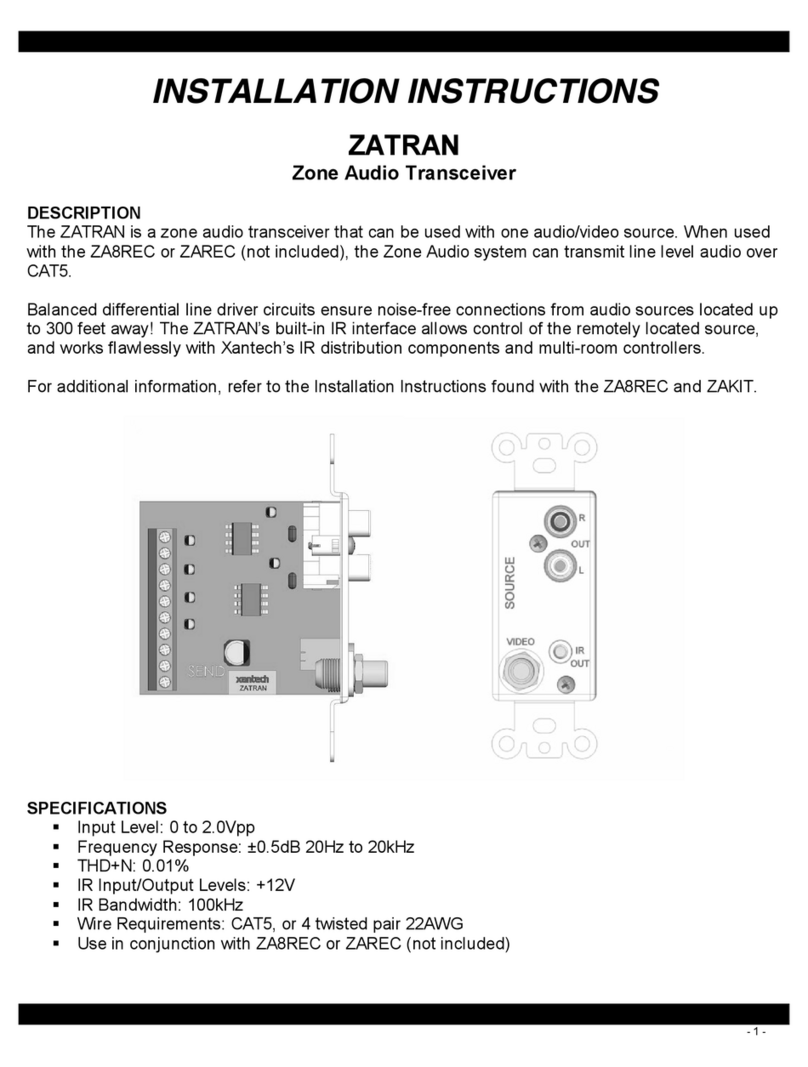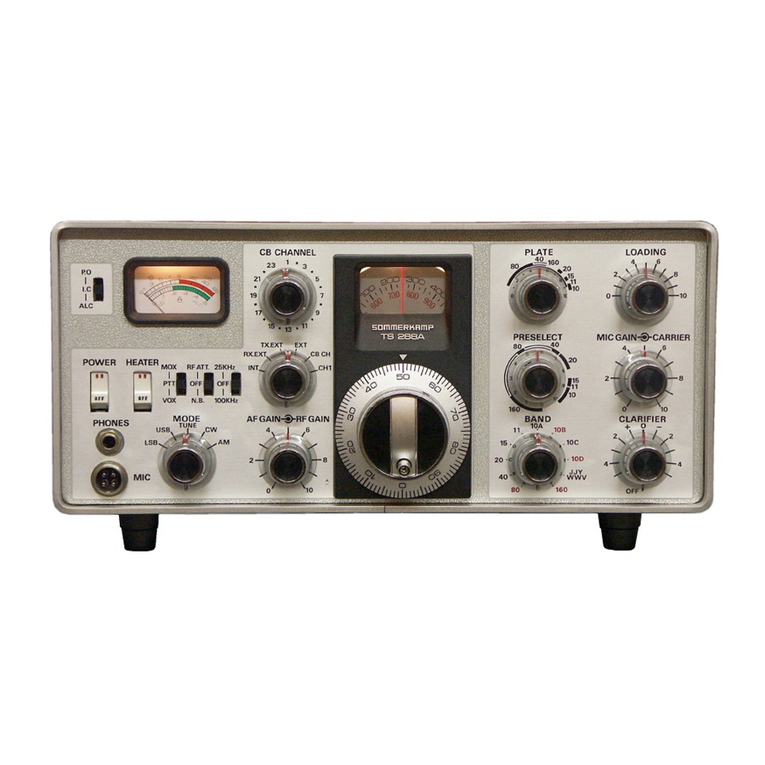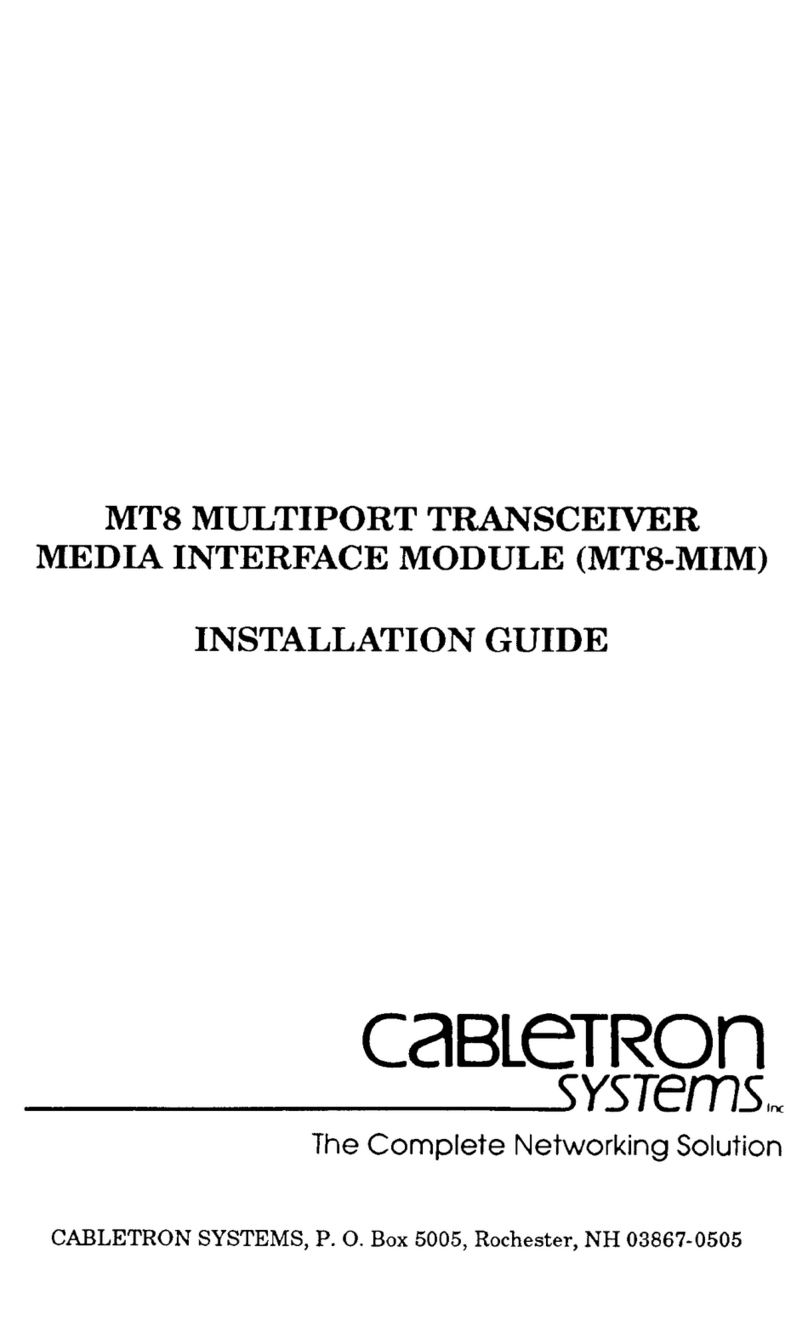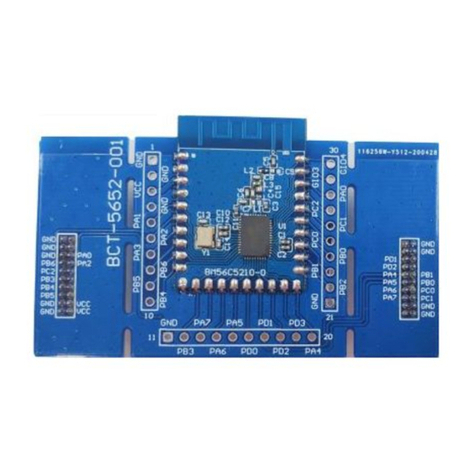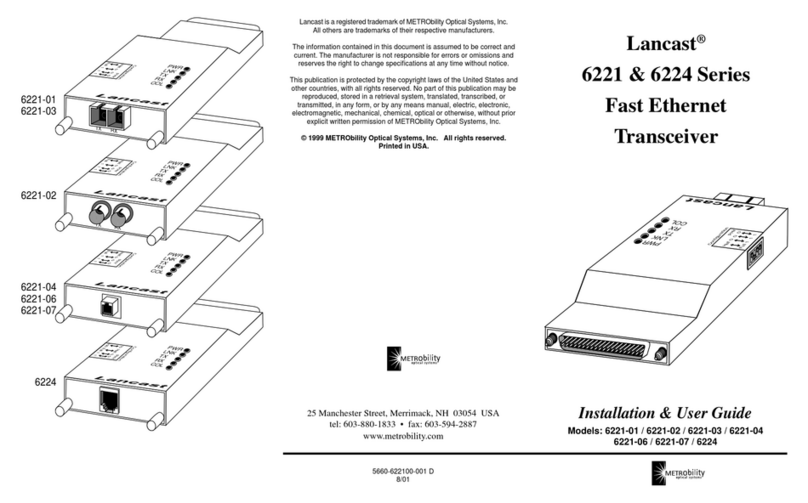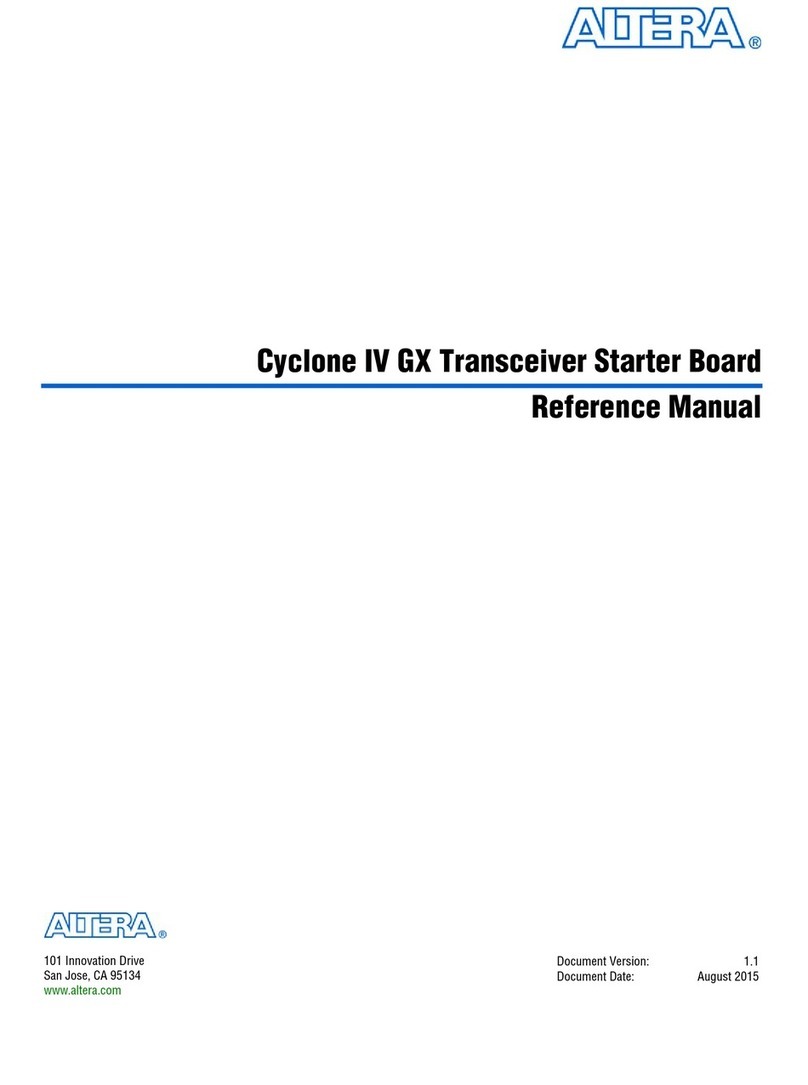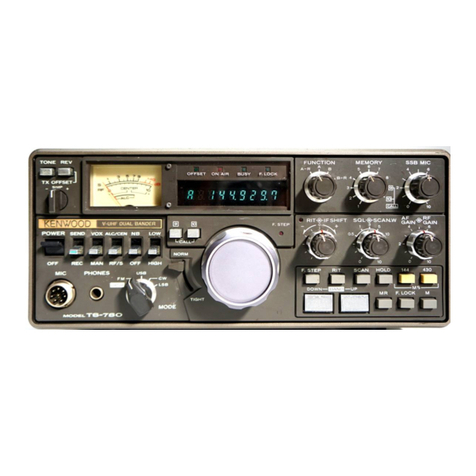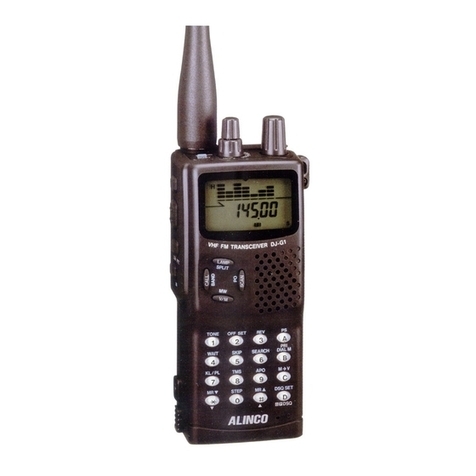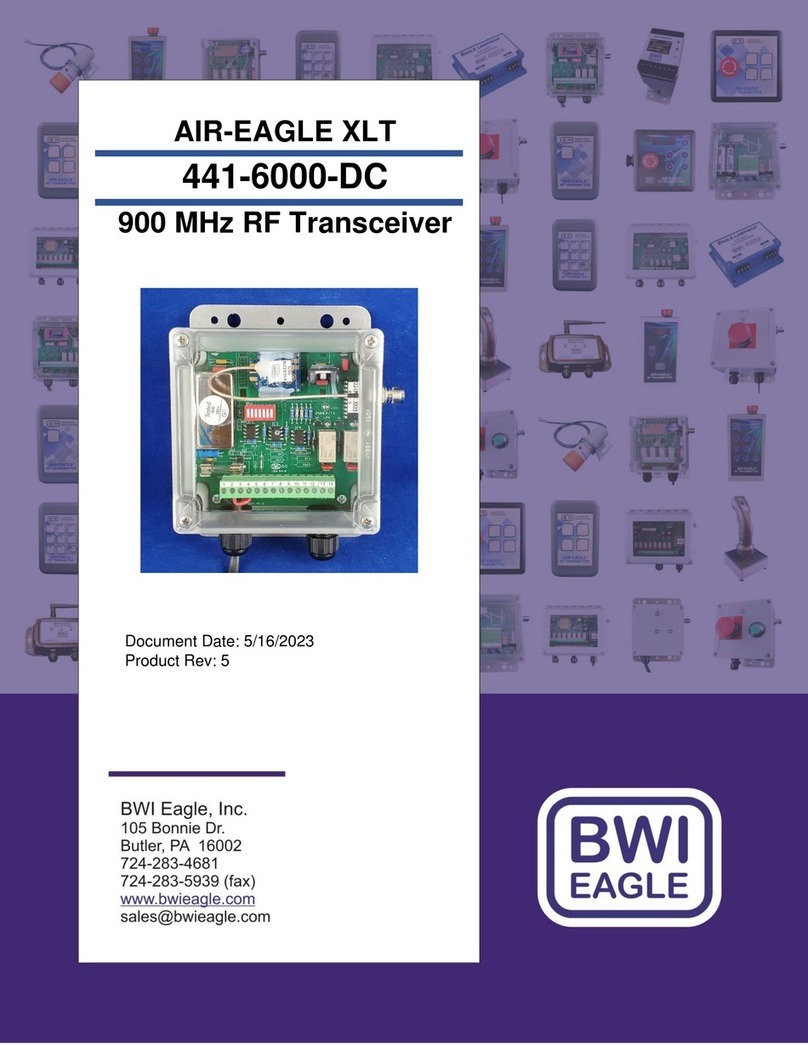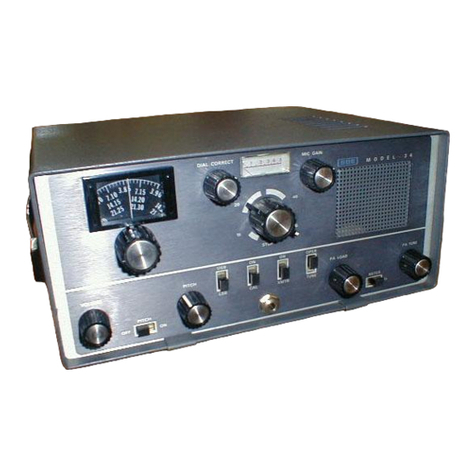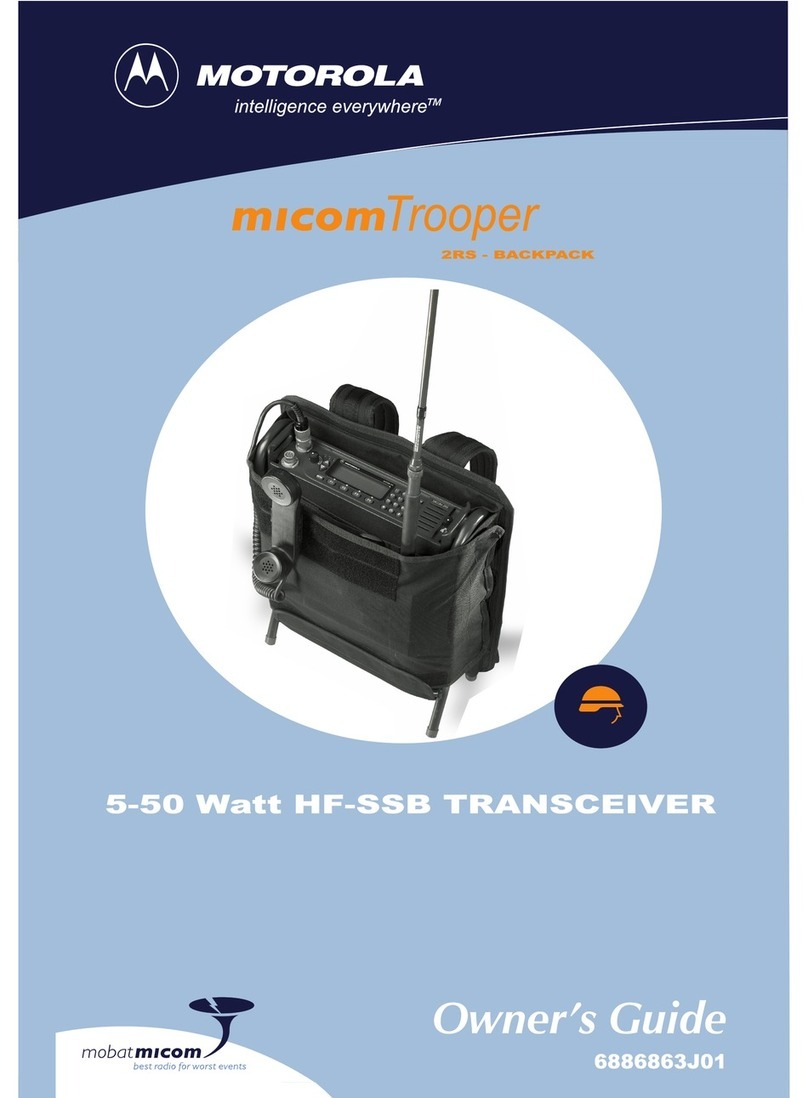Icom IC-7000 User manual

HF/VHF/UHF
ALL MODE TRANSCEIVER
i7000
INSTRUCTION MANUAL

i-1
IMPORTANT
READ THIS INSTRUCTION MANUAL
CAREFULLY before attempting to operate the
transceiver.
SAVE THIS INSTRUCTION MANUAL. This
manual contains important safety and operating in-
structions for the IC-7000.
EXPLICIT DEFINITIONS
WORD DEFINITION
RRWARNING Personal injury, fire hazard or electric
shock may occur.
CAUTION Equipment damage may occur.
NOTE If disregarded, inconvenience only. No
risk or personal injury, fire or electric
shock.
We understand that you have a choice of many differ-
ent radios in the market place. We want to take a cou-
ple of moments of your time to thank you for making
the IC-7000 your radio of choice, and hope you agree
with Icom’s philosophy of “technology first.” Many
hours of research and development went into the de-
sign of your IC-7000.
D
FEATURES
❍IF DSP features
❍All mode capability covering 160–2 m and
70 cm (depending on version)
❍Compact with detachable front panel
❍±0.5 ppm of high frequency stability
❍Baudot RTTY demodulator
❍Simple band scope function
❍Selectable SSB transmission passband
width (For both higher and lower pass fre-
quency)
❍Standard voice synthesizer/voice recorder
The transceiver comes with the following acces-
sories. Qty.
qHand microphone (HM-151) ........................ 1
wDC power cable* (OPC-1457) ..................... 1
or (OPC-1457R) ............... 1
eSpare fuse (ATC 5 A) ................................... 1
rSpare fuse (ATC 30 A) ................................. 2
tACC cable......................................................1
y3.5 (d) mm plug..............................................1
u6.5 (d) mm Electronic keyer plug...................1
iMicrophone hanger........................................1
oFerrite bead**.................................................1
* Depending on versions.
**Not supplied with non-European versions.
q
e
t
w
w
yu
r
i
o
For European versions
(see p. 19 for installation details)
FOREWORD SUPPLIED ACCESSORIES
Icom, Icom Inc. and the logo are registered trademarks
of Icom Incorporated (Japan) in the United States, the United
Kingdom, Germany, France, Spain, Russia and/or other
countries.
Spurious signals may be received near the following fre-
quencies. These are created in the internal circuit and does
not indicate a transceiver malfunction:
52.76497 MHz,
443.03535 MHz
THIS P
THIS PAGE
AGE
OPEN
OPEN

i-2
SPCH
/LOCK TUNER
/CALL XFC
V/M
F-1 F-2
FIL
MODE
GENE
MW
123
456
789
.
0
CE F-INP
ENT
1.8 3.5 7
10 14 18
21 24 28
50 144 430
Mic element
q
e
w
o
!7!8!9@0@2@3@4 @1
t
r
yu !2
!5
!6
!1!0i
!3
!4
z
c
v
bn
m
,
.⁄0
⁄2
⁄3
⁄1
x
Front panel
HM-151
The front panel and HM-151’s panel
descriptions are descrived on pages
1 to 4, and on page 9, respectively
(see the Chapter 1 ‘PANEL DE-
SCRIPTION’ for more details).
ILLUSTRATIONS

i-3
■Front panel
qAF GAIN CONTROL [AF] (inner control; p. 33)
wRF GAIN CONTROL/SQUELCH CONTROL
[RF/SQL] (outer control; p. 35)
ePOWER KEY [PWR] (p. 25)
rFRONT PANEL LATCH (p. 16)
tPASSBAND TUNING/M-ch/RIT CONTROLS
[PBT/M-ch/RIT] (pgs. 73, 77, 86, 100, 104)
yTWIN PBT (M-ch/RIT) INDICATOR
(pgs. 73, 77, 86, 100)
uMENU/GROUP KEYS [MENU/GRP] (p. 151)
iTUNER/CALL KEY [TUNER/CALL]
(pgs. 100, 114)
oMULTI-FUNCTION KEYS [F1]/[F2]/[F3]/[F4]
(pgs. 5–8, 151)
!0 MANUAL NOTCH KEY [MNF/ADJ] (p. 81)
!1 AUTO NOTCH/VOICE RECORDER KEY
[ANF/•REC] (pgs. 80, 93)
!2 SPCH/LOCK KEY [SPCH/LOCK] (pgs. 34, 37)
!3 MICROPHONE CONNECTOR (p. 10)
!4
UP/DOWN (BAND) KEYS
[Y(
BAND
)]/[ZZ(
BAND
)]
!5 MAIN DIAL TENSION LATCH
!6 HEADPHONE JACK [PHONES] (p. 18)
!7 MAIN DIAL [DIAL]
!8 RECEIVE/TRANSMIT INDICATORS [RX]/[TX]
!9 TUNING STEP KEY [TS] (pgs. 30–32)
@0 NOISE BLANKER KEY [NB/ADJ] (p. 78)
@1 NOISE REDUCTION KEY [NR/LEV] (p. 79)
@2 FUNCTION DISPLAY (p. 13)
@3 PRE AMP/ATTENUATOR KEY [P.AMP/ATT]
(p. 72)
@4 MODE KEY [MODE] (p. 34)
■Microphone (HM-151)
zSPCH/LOCK KEY [SPCH/LOCK] (p. 34, 37)
xPTT SWITCH [PTT] (p. 37)
cUP/DOWN SWITCHES [YY]/[ZZ]
vTRANSMIT INDICATOR (p. 37)
bKEYPAD (pgs. 28, 29)
nFILTER SELECTION [FIL] (p. 75)
mMODE KEY [MODE] (p. 34)
,POWER INDICATOR
.PROGRAMMABLE FUNCTION KEYS [F-1]/[F-2]
⁄0 MEMORY WRITE [MW] (pgs. 101, 102)
⁄1 VFO/MEMORY SELECTION [V/M]
(pgs. 27, 100, 107)
⁄2 TRANSMIT FREQUENCY CHECK [XFC]
(pgs. 65, 89)
⁄3 TUNER/CALL KEY [TUNER/CALL]
(pgs. 100, 114)

ii
RWARNING RF EXPOSURE! This device emits
Radio Frequency (RF) energy. Extreme caution should be
observed when operating this device. If you have any
questions regarding RF exposure and safety standards
please refer to the Federal Communications Commission
Office of Engineering and Technology’s report on Evalu-
ating Compliance with FCC Guidelines for Human Radio
Frequency Electromagnetic Fields (OET Bulletin 65).
RWARNING HIGH VOLTAGE! NEVER touch an
antenna or internal antenna connector during transmis-
sion. This may result in an electrical shock or burn.
RWARNING! NEVER operate the transceiver while
driving a vehicle. Safe driving requires your full atten-
tion—anything less may result in an accident.
RNEVER apply AC power to the [DC13.8V] socket on
the transceiver rear panel. This could cause a fire or dam-
age the transceiver.
RNEVER apply more than 16 V DC, such as a 24 V
battery, to the [DC13.8V] socket on the transceiver rear
panel. This could cause a fire or damage the transceiver.
RNEVER let metal, wire or other objects touch any in-
ternal part or connectors on the rear panel of the trans-
ceiver. This may result in an electric shock or this could
cause a fire or damege the transceiver.
RNEVER connect or use the supplied HM-151 (micro-
phone) with other transceiver. This could cause damage
to the transceiver. The HM-151 is designed for use with
the IC-7000 ONLY.
NEVER expose the transceiver to rain, snow or any liq-
uids.
AVOID using or placing the transceiver in areas with tem-
peratures below –10°C (+14°F) or above +60°C (+140°F).
Be aware that temperatures on a vehicle’s dashboard can
exceed +80°C (+176°F), resulting in permanent damage
to the transceiver if left there for extended periods.
AVOID placing the transceiver in excessively dusty envi-
ronments or in direct sunlight.
AVOID placing the transceiver against walls or putting
anything on top of the transceiver. This will obstruct heat
dissipation.
Place unit in a secure place to avoid inadvertent use by
children.
During mobile operation, NEVER place the transceiver
where air bag deployment may be obstructed.
During mobile operation, DO NOT place the transceiver
where hot or cold air blows directly onto it.
During mobile operation, DO NOT operate the transceiver
without running the vehicle’s engine. When the trans-
ceiver’s power is ON and your vehicle’s engine is OFF,
the vehicle’s battery will soon become exhausted.
Make sure the transceiver power is OFF before starting
the vehicle engine. This will avoid possible damage to the
transceiver by ignition voltage spikes.
During maritime mobile operation, keep the transceiver
and microphone as far away as possible from the mag-
netic navigation compass to prevent erroneous indica-
tions.
BE CAREFUL! The rear panel will become hot when op-
erating the transceiver continuously for long periods.
BE CAREFUL! If a linear amplifier is connected, set the
transceiver’s RF output power to less than the linear am-
plifier’s maximum input level, otherwise, the linear ampli-
fier will be damaged.
Use Icom microphones only (supplied or optional). Other
manufacturer’s microphones have different pin assign-
ments, and connection to the IC-7000 may damage the
transceiver.
For U.S.A. only
Caution: Changes or modifications to this transceiver,
not expressly approved by Icom Inc., could void your
authority to operate this transceiver under FCC regu-
lations.
PRECAUTIONS

iii
IMPORTANT …………………………………………i-1
FOREWORD ………………………………………… i-1
EXPLICIT DEFINITIONS …………………………… i-1
SUPPLIED ACCESSORIES …………………………i-1
ILLUSTRATIONS ……………………………………i-2
■Front panel ……………………………………… i-3
■Microphone (HM-151) ………………………… i-3
PRECAUTIONS ………………………………………ii
TABLE OF CONTENTS …………………………… iii
1PANEL DESCRIPTION ………………… 1–14
■Front panel ………………………………………… 1
■Multi-function keys ……………………………… 5
DMenu M-1 functions …………………………… 5
DMenu M-2 functions …………………………… 5
DMenu M-3 functions …………………………… 5
DMenu S-1 functions …………………………… 7
DMenu S-2 functions …………………………… 7
DMenu S-3 functions …………………………… 8
DMenu G-1 (Scope) functions ………………… 8
■Microphone (HM-151) …………………………… 9
DMicrophone connector ……………………… 10
■Rear panel ……………………………………… 11
DDATA socket …………………………………… 12
DACC socket …………………………………… 12
■Function display ………………………………… 13
2INSTALLATION AND CONNECTIONS 15–24
■Unpacking ……………………………………… 15
■Selecting a location……………………………… 15
■Grounding………………………………………… 15
■Antenna connection……………………………… 15
■Installation ……………………………………… 16
DSingle body mounting ………………………… 16
DStand …………………………………………… 16
DFront panel separation ……………………… 16
DFront panel mounting ………………………… 16
■Required connections…………………………… 17
■Advanced connections ………………………… 18
■Power supply connections……………………… 19
■Connecting a DC power supply ……………… 19
■Battery connections …………………………… 19
■External antenna tuners………………………… 20
■Linear amplifier connections …………………… 21
■Connections for CW …………………………… 22
■Connections for RTTY ………………………… 23
DConnections for RTTY (FSK)………………… 23
DConnections for RTTY (AFSK) ……………… 23
■Connections for packet, SSTV or PSK31 …… 24
DWhen connecting to [DATA] socket ………… 24
DWhen connecting to [ACC] socket ………… 24
DWhen connecting to [MIC] connector ……… 24
3BASIC OPERATION ……………………25–38
■When first applying power (CPU resetting)…… 25
DMenu resetting (M-1)………………………… 25
■Initial settings …………………………………… 25
■VFO description ………………………………… 26
DDifferences between VFO and
memory mode ………………………………… 26
■VFO operation …………………………………… 27
DSelecting VFO A/VFO B ……………………… 27
DVFO equalization……………………………… 27
■Selecting VFO/memory mode ………………… 27
■Selecting an operating band …………………… 28
DUsing the band stacking registers…………… 28
■Frequency setting ……………………………… 29
DTuning with the main dial …………………… 29
DDirect frequency entry
with the microphone’s keypad ……………… 29
DProgrammable tuning step…………………… 30
DSelecting “kHz” step ………………………… 30
DSelecting 1 Hz or 10 Hz step
(SSB/CW/RTTY only) ………………………… 31
D1 MHz quick tuning step
(FM/WFM/AM only) …………………………… 31
D1⁄4tuning function (CW/RTTY only) ………… 32
DAuto tuning step function …………………… 33
DBand edge warning beep …………………… 33
■Volume setting …………………………………… 33
■Operating mode selection ……………………… 34
■Voice synthesizer function ……………………… 34
■Squelch and receive (RF) sensitivity ………… 35
■Meter function …………………………………… 36
DMulti-function meter…………………………… 36
■Lock functions …………………………………… 37
DDial lock function ……………………………… 37
DMicrophone lock function …………………… 37
■Basic transmit operation ……………………… 37
DTransmitting …………………………………… 37
DSetting output power ………………………… 38
DSetting microphone gain……………………… 38
4RECEIVE AND TRANSMIT …………… 39–69
■Operating SSB…………………………………… 39
DConvenient functions for receive …………… 39
DConvenient functions for transmit …………… 40
DAbout 5 MHz band operation
(USA version only) …………………………… 40
■Operating CW …………………………………… 41
DConvenient functions for receive …………… 42
DConvenient functions for transmit …………… 42
DCW reverse mode …………………………… 43
DCW side tone function………………………… 43
DCW pitch control ……………………………… 44
■Electronic CW keyer …………………………… 45
DMemory keyer send menu …………………… 46
DEditing a keyer memory ……………………… 47
DContest number set mode …………………… 48
1 Number Style ……………………………… 48
2 Count UP Trigger …………………………… 48
3 Present Number …………………………… 48
DKeyer set mode ……………………………… 49
1 Keyer Repeat Time ………………………… 49
2 Dot/Dash Ratio……………………………… 49
3 Rise Time …………………………………… 50
TABLE OF CONTENTS

iv
4 Paddle Polarity ……………………………… 50
5 Keyer Type ………………………………… 50
6 MIC U/D Keyer (HM-103) ………………… 50
DPaddle operation from [MIC] connector …… 50
■Operating RTTY (FSK) ………………………… 51
DConvenient functions for receive …………… 52
DRTTY reverse mode ………………………… 53
DTwin peak filter………………………………… 53
DFunctions for the RTTY decoder indication… 54
DSetting the decoder threshold level ………… 54
DRTTY decode set mode ……………………… 55
1 RTTY Decode USOS ……………………… 55
2 RTTY Decode New Line Code …………… 55
D
Pre-setting for using RTTY terminal or TNC
…56
■Operating AM …………………………………… 57
DConvenient functions for receive …………… 57
DConvenient functions for transmit …………… 58
■Operating FM …………………………………… 59
DConvenient functions for receive …………… 59
DConvenient functions for transmit …………… 59
DTone squelch operation ……………………… 60
DDTCS operation ……………………………… 61
DTone scan operation ………………………… 62
■Repeater operation ……………………………… 63
DOne-touch repeater function ………………… 63
DRepeater tone frequency …………………… 64
DTransmit frequency monitor check ………… 65
DAuto repeater function (USA version only) … 65
DStoring a non standard repeater …………… 66
■1750 Hz tone burst ……………………………… 67
■DTMF memory encoder ………………………… 67
DDTMF send menu …………………………… 67
DProgramming a DTMF code ………………… 68
DDTMF speed…………………………………… 68
5FUNCTIONS FOR RECEIVE…………… 69–82
■Simple band scope ……………………………… 69
DFix mode ……………………………………… 70
DCenter mode…………………………………… 71
DScope set mode ……………………………… 71
1 Max Hold …………………………………… 72
2 Scope Size ………………………………… 72
3 FAST Sweep………………………………… 72
4 FAST Sweep Sound ……………………… 72
■Preamp and attenuator ………………………… 72
■RIT function ……………………………………… 73
■AGC function …………………………………… 74
DAGC time constant selection ………………… 74
DSetting the AGC time constant ……………… 74
■IF filter selection ………………………………… 75
DIF filter selection ……………………………… 75
DFilter passband width setting
(SSB/CW/RTTY/AM only) …………………… 76
DIF filter shape (SSB/CW only) ……………… 76
■Twin PBT operation …………………………… 77
■Noise blanker …………………………………… 78
DNoise blanker set mode ……………………… 78
1 NB Level …………………………………… 78
2 NB Width …………………………………… 78
■Noise reduction ………………………………… 79
DNoise reduction set mode …………………… 79
➥NR Level …………………………………… 79
■Notch function …………………………………… 80
DAuto notch function …………………………… 80
DManual notch function………………………… 81
DManual notch filter set mode ………………… 81
■Voice squelch control function ………………… 82
■Meter peak hold function ……………………… 82
6FUNCTIONS FOR TRANSMIT ………… 83–92
■VOX function …………………………………… 83
DAdjusting the VOX function ………………… 83
DVOX set mode ………………………………… 84
1 VOX Gain …………………………………… 84
2 Anti-VOX …………………………………… 84
3 VOX Delay ………………………………… 84
■Transmit filter width setting (SSB only) ……… 84
■Break-in function ………………………………… 85
DSemi break-in operation ……………………… 85
DFull break-in operation ……………………… 85
■∂TX function …………………………………… 86
■Monitor function ………………………………… 87
■Speech compressor …………………………… 87
DCompression level setting …………………… 88
➥COMP Level ……………………………… 88
■Split frequency operation ……………………… 89
■Quick split function ……………………………… 90
DSplit offset frequency setting ………………… 91
DQuick split setting …………………………… 91
■Measuring SWR ………………………………… 92
DSpot measurement …………………………… 92
DPlot measurement …………………………… 92
7VOICE RECORDER FUNCTIONS …… 93–99
■Digital voice recorder …………………………… 93
■Recording a received audio …………………… 93
DBasic recording ……………………………… 93
DOne-touch voice recording…………………… 94
■Playing the recorded contents ………………… 94
■Erasing the recorded contents ………………… 95
■Recording a message for transmit …………… 96
DRecording ……………………………………… 96
DConfirming/Erasing the recorded message… 96
■Programming a memory name for transmit … 97
■Sending a recorded message ………………… 98
DTransmit level setting ………………………… 98
■Voice set mode ………………………………… 99
DVoice set mode ……………………………… 99
1 Auto Monitor ………………………………… 99
2 MIC Memo…………………………………… 99
8MEMORY OPERATION ……………… 100–110
■Memory channels ……………………………… 100
■Memory channel selection …………………… 100
■Memory programming ………………………… 101
DProgramming in VFO mode………………… 101
DProgramming in memory mode …………… 102
■Memory channel list …………………………… 103
TABLE OF CONTENTS
1
2
3
4
5
6
7
8
9
10
11
12
13
14
15
16
17
18
19
20
21

v
DSelecting a memory channel
using the memory channel list……………… 103
DSetting a memory channel
as a select memory ………………………… 104
DSelecting a memory bank ………………… 104
DMemory names ……………………………… 105
■Memory clearing ……………………………… 106
DMemory clearing
using the memory channel list……………… 106
■Frequency transferring………………………… 107
DTransferring in VFO mode ………………… 107
DTransferring in memory mode ……………… 108
■Memo pads …………………………………… 109
DWriting frequencies and operating modes
into memo pads ……………………………… 109
DCalling up a frequency from a memo pad … 110
9SCAN OPERATION ………………… 111–113
■Scan types ……………………………………… 111
■Preparation……………………………………… 111
■Programmed scan operation ………………… 112
■Memory scan operation ……………………… 112
■Select memory scan operation ……………… 113
■Priority watch …………………………………… 113
10 ANTENNA TUNER OPERATION … 114–115
■Optional AT-180
AUTOMATIC ANTENNA TUNER
operation………………………………………… 114
DTuner operation ……………………………… 114
DManual tuning………………………………… 114
■Optional AH-4
AUTOMATIC ANTENNA TUNER
operation………………………………………… 115
DAH-4 operation ……………………………… 115
11 PACKET OPERATION …………………… 116
■Packet operation ……………………………… 116
DData socket…………………………………… 116
DAdjusting the data speed …………………… 116
DAdjusting the transmit signal output
from the TNC ………………………………… 116
12 CLOCK AND TIMERS ……………… 117–119
■Time set mode ………………………………… 117
1 Year ………………………………………… 117
2 Date ………………………………………… 117
3 Time (Now) ………………………………… 117
4 CLOCK2 Function ………………………… 117
5 CLOCK2 Offset …………………………… 117
6 Auto Power OFF …………………………… 117
DSetting the current year …………………… 118
DSetting the current date …………………… 118
DSetting the current time …………………… 118
DClock2 function activity ……………………… 119
DClock2 offset setting ………………………… 119
DAuto power OFF activity …………………… 119
13 SET MODE ………………………… 120–136
■Set mode description ………………………… 120
■Quick set mode ………………………………… 121
➥RF Power (all modes) ……………………… 121
➥MIC Gain (SSB/AM/FM modes)…………… 121
➥SSB TBW (WIDE) L (SSB mode) ………… 121
➥SSB TBW (WIDE) H (SSB mode) ………… 122
➥SSB TBW (MID) L (SSB mode) …………… 122
➥SSB TBW (MID) H (SSB mode) ………… 122
➥SSB TBW (NAR) L (SSB mode) ………… 122
➥SSB TBW (NAR) H (SSB mode) ………… 122
➥Key Speed (CW mode) …………………… 122
➥CW Pitch (CW mode) ……………………… 122
➥Side Tone Level (CW mode) ……………… 123
➥Side Tone Level Limit (CW mode)………… 123
➥Twin Peak Filter (RTTY mode) …………… 123
➥RTTY Mark Frequency (RTTY mode) …… 123
➥RTTY Shift Width (RTTY mode) ………… 123
➥RTTY Keying Polarity (RTTY mode) ……… 123
■Display set mode ……………………………… 124
1 Contrast (LCD)……………………………… 124
2 Bright (LCD) ………………………………… 124
3 LCD Unit Bright …………………………… 124
4 LCD Flicker ………………………………… 124
5 Backlight (Switches) ……………………… 124
6 Display Type………………………………… 124
7 Display Font Type ………………………… 125
8 Display Font Size ………………………… 125
9 Meter Peak Hold …………………………… 125
10 Filter Popup (PBT) ………………………… 125
11 Filter Popup (FIL)…………………………… 125
12 1 Hz Mode Popup ………………………… 125
13 Scope CENTER/FIX Popup ……………… 125
14 TV Popup (CH Up/Down) ………………… 126
15 TV Popup (P.AMP/ATT) …………………… 126
16 Voice TX Name Display …………………… 126
17 Keyer Memory Display …………………… 126
18 DTMF Memory Display …………………… 126
19 External Display …………………………… 126
20 Opening Message ………………………… 126
21 My Call ……………………………………… 127
22 Power ON Check…………………………… 127
■Miscellaneous (others) set mode …………… 128
1 Monitor ……………………………………… 128
2 Monitor Level ……………………………… 128
3 Beep (Confirmation) ……………………… 128
4 Beep (Band edge) ………………………… 128
5 Beep Level ………………………………… 128
6 Beep Level Limit …………………………… 128
7 RF/SQL Control …………………………… 129
8 Quick SPLIT ………………………………… 129
9 SPLIT Offset………………………………… 129
10 SPLIT LOCK………………………………… 129
11 DUP Offset HF ……………………………… 129
12 DUP Offset 50M …………………………… 129
13 DUP Offset 144M ………………………… 130
14 DUP Offset 430M ………………………… 130
15 One Touch Repeater ……………………… 130
16 Auto Repeater ……………………………… 130
TABLE OF CONTENTS

vi
17 Tuner (Auto Start) ………………………… 130
18 Tuner (PTT start) …………………………… 131
19 [TUNER] Switch …………………………… 131
20 VSEND Select ……………………………… 131
21 SPEECH Level …………………………… 131
22 SPEECH Language ……………………… 131
23 SPEECH Speed …………………………… 131
24 SPEECH S-Level ………………………… 132
25 SPEECH [MODE] Switch ………………… 132
26 Memopad Numbers ……………………… 132
27 SCAN Speed ……………………………… 132
28 SCAN Resume …………………………… 132
29 MAIN DIAL Auto TS ……………………… 132
30 HM-151 [F-1] ……………………………… 133
31 HM-151 [F-2] ……………………………… 133
32 MIC Up/Down Speed ……………………… 133
33 Quick RIT/∂TX Clear ……………………… 133
34 SSB/CW Synchronous Tuning …………… 133
35 CW Normal Side …………………………… 134
36 VOICE 1st Menu ………………………… 134
37 KEYER 1st Menu ………………………… 134
38 DTMF 1st Menu …………………………… 134
39 Mode Select (SSB) ………………………… 134
40 Mode Select (CW) ………………………… 134
41 Mode Select (RTTY) ……………………… 134
42 Mode Select (AM) ………………………… 135
43 Mode Select (FM) ………………………… 135
44 Mode Select (WFM) ……………………… 135
45 External Keypad (VOICE) ………………… 135
46 External Keypad (KEYER)………………… 135
47 Front Keypad Type ………………………… 136
48 CI-V Baud Rate …………………………… 136
49 CI-V Address ……………………………… 136
50 CI-V Transceive …………………………… 136
51 REF Adjust ………………………………… 136
14 MAINTENANCE ………………………… 137
■Fuse replacement ……………………………… 137
■Memory backup………………………………… 137
■Cleaning ………………………………………… 137
15 TROUBLESHOOTING …………… 138–139
16 OPTIONAL UNITS SETTING ……… 140–141
■MB-106
CARRYING HANDLE
…………………… 140
■Band voltage modification …………………… 140
■AT-180 internal switch description …………… 141
17 CONTROL COMMAND …………… 142–147
■Remote jack (CI-V) information ……………… 142
DCI-V connection example…………………… 142
DData format…………………………………… 142
DCommand table ……………………………… 142
DTo send/read memory contents …………… 146
DBand stacking register ……………………… 146
DCodes for memory keyer contents ………… 146
DCharacter codes for My Call ……………… 147
DCodes for memory name contents ………… 147
DSplit/Duplex frequency setting……………… 147
DRepeater tone/tone squelch frequency
setting ………………………………………… 147
DDTCS code and polarity setting …………… 147
18 SPECIFICATIONS ………………………… 148
■General ………………………………………… 148
■Transmitter ……………………………………… 148
■Receiver ………………………………………… 148
19 OPTIONS …………………………… 149–150
20 MENU GUIDE ……………………… 151–152
21 ABOUT CE ………………………… 153–154
TABLE OF CONTENTS
1
2
3
4
5
6
7
8
9
10
11
12
13
14
15
16
17
18
19
20
21

qAF GAIN CONTROL [AF(
SET
)] (inner control; p. 33)
➥Rotate to vary the audio output level from the
speaker or headphones.
Push momentarily to enter the set mode menu.
•Push again to exit the set mode menu.
wRF GAIN CONTROL/SQUELCH CONTROL
[RF/SQL] (outer control; p. 35)
Adjusts the RF gain and squelch threshold level.
The squelch, when closed, mutes the speaker or
headphones when no signal is received, reducing
noise.
•The squelch is particularly effective for FM mode. It is
also available in other modes.
•12 to 1 o’clock position is recommended for any setting
of the [RF/SQL] control.
•The control can be set to ‘Auto’ (RF gain control in SSB,
CW and RTTY; squelch control in AM, FM and WFM) or
squelch control (RF gain is fixed at maximum) in the mis-
cellaneous (others) set mode as follows. (p. 129)
•When functioning as RF gain/squelch control
•When functioning as RF gain control
(Squelch is fixed open; SSB, CW, RTTY only)
•When functioning as squelch control
(RF gain is fixed at maximum.)
ePOWER KEY [PWR] (p. 25)
➥While transceiver’s power is OFF, push to turn the
power ON.
•Turn the DC power supply ON in advance.
➥While transceiver’s power is ON, push and hold
for 1 sec. to turn the power OFF.
rFRONT PANEL LATCH (p. 16)
Pull away from the transceiver (towards yourself
when looking at the front of the transceiver) to de-
tach the front panel from the main body of the trans-
ceiver.
tPASSBAND TUNING/M-ch/RIT CONTROLS
[PBT/M-ch/RIT]
➥Push inner control to toggle the twin Passband
Tuning (PBT) or memory channel/RIT function
ON and OFF.
➥While Twin PBT is selected (p. 77):
●
●
Adjusts the receiver’s DSP filter passband
width.
•Passband width and shift frequency are displayed
on the LCD.
•The default variable range is half of the IF filter
passband width. 25 Hz step is available.
●
●
Push and hold inner control for 1 sec. to return
the PBT to default settings.
Low cutHigh cut Center
+–
PBT1
PBT2
Squelch is
open.
S-meter
squelch
S-meter squelch
threshold
Noise squelch
threshold
(FM mode)
Lowest threshold Highest threshold
Noise squelch (FM mode)
Minimum RF gain
Adjustable
range
Maximum RF gain
Recommended level
RF gain
adjustable
range
Maximum
RF gain
S-meter shows
squelch level
Noise squelch (FM mode)
Squelch is
open.
MODE
SSB, CW
RTTY
AM, FM
WFM
Auto
RF GAIN
SQL
SQL
SET MODE SELECTION
SQL
SQL
RF + SQL
RF + SQL
RF + SQL
Audio outut
decreases
Audio output
increases
1
1
PANEL DESCRIPTION
■Front panel
See the illustration of the Front panel on page i-2.

✔
What is the PBT control?
PBT electronically narrows the IF passband width to reject
interference. This transceiver uses DSP to implement PBT.
➥While M-ch/RIT is selected:
●
●
Rotate the inner control to select a memory
channel number (p. 100).
●
●
Push and hold inner control for 1 sec. to turn
the RIT/∂TX mode ON (pgs. 73, 86).
•Push [ZZ(
MENU
/
GRP
)] to exit the RIT/∂TX mode.
●
●
While the RIT/∂TX mode is OFF:
Rotate outer control to select a memory bank
(p. 104).
●
●
While the RIT/∂TX is ON:
Rotate outer control to shift the receive or
transmit frequency (pgs. 73, 86).
•“ ” or “ ” indicators appear when the RIT or
∂TX function is activate, respectively.
•The shift frequency range is ± 9.999 kHz in 1 Hz
steps (or ±9.99 kHz in 10 Hz steps).
•When the RIT or ∂TX function is ON, push and
hold [F-1 RRIITT]or [F-2 ∂∂TTXX]for 1 sec. to add or
subtract the frequency shift to the display fre-
quency.
✔
What is the RIT function?
RIT (Receiver Incremental Tuning) shifts the receive fre-
quency without shifting the transmit frequency.
This is useful for fine tuning for stations calling you off fre-
quency or when you prefer to listen to slightly different-
sounding voice characteristics, etc.
✔
What is the
∂∂
TX function?
The ∂TX shifts the transmit frequency without shifting the re-
ceive frequency. This is useful for simple split frequency op-
eration in CW, etc.
yTWIN PBT (M-ch/RIT) INDICATOR
(pgs. 73, 77, 86, 100)
➥Indicates the status of [PBT/M-ch/RIT] (t) as the
Twin PBT function or memory channel/RIT con-
trol.
•Indicator is green when the Twin PBT is selected.
•Indicator is off when the M-ch/RIT is selected.
uMENU/GROUP KEYS [MENU/GRP] (p. 151)
➥Push either key one or more times to select
menus within a menu group (MM, SSor GG(Graphic)).
➥Push and hold for 1 sec. to select one of the three
menu groups: MM
--
11to MM
--
33, SS
--
11to SS
--
33and GG
--
11
(Scope) to GG
--
33(SWR meter).
iTUNER/CALL KEY [TUNER/CALL]
➥During HF/50 MHz operation (p. 114):
●
●
Push momentarily to toggle the automatic an-
tenna tuner function ON and OFF.
•An optional antenna tuner must be connected.
•“ ” indicator appears when the tuner is ON.
●
●
Push and hold for 2 sec. to manually tune the
antenna.
•An optional antenna tuner must be connected.
•“ ” indicator appears when the tuner is ON.
➥During 144/430 MHz operation (p. 100):
Push momentarily to select the call channel (or
return to the previous channel/frequency when
the call channel is already selected).
•“C1” is the 144 MHz call channel and “C2” is the 430
MHz call channel.
oMULTI-FUNCTION KEYS [F-1]/[F-2]/[F-3]/[F-4]
➥Push to select the function indicated in the LCD
display above these keys. (pgs. 5–8, 151)
•Functions vary depending on the active menu.
Functions appear
M-ch
RIT
M-ch RIT
Frequency
decreases
Frequency
increases
Channel
decreases
Channel
increases
∂TX
RIT
2
1
PANEL DESCRIPTION
1
See the illustration of the Front panel on page i-2.

IC-7000
#02
(Europe)
IC-7000
#03
(France)
IC-7000
#04
(Spain)
IC-7000
#09
(Italy)
IC-7000
#10
(UK)
1-1-32 Kamiminami, Hirano-ku, Osaka 547-0003, Japan
<Intended Country of Use>
■GER ■■FRA ■■ESP ■SWE
■AUT ■NED ■POR ■DEN
■■GBR ■BEL ■ITA ■FIN
■IRL ■LUX ■■GRE ■■SUI
■■NOR
<Intended Country of Use>
■■GER ■FRA ■■ESP ■■SWE
■■AUT ■■NED ■■POR ■■DEN
■■GBR ■■BEL ■■ITA ■■FIN
■■IRL ■■LUX ■■GRE ■■SUI
■■NOR
<Intended Country of Use>
■■GER ■■FRA ■ESP ■■SWE
■■AUT ■■NED ■■POR ■■DEN
■■GBR ■■BEL ■■ITA ■■FIN
■■IRL ■■LUX ■■GRE ■■SUI
■■NOR
<Intended Country of Use>
■■GER ■■FRA ■■ESP ■■SWE
■■AUT ■■NED ■■POR ■■DEN
■■GBR ■■BEL ■ITA ■■FIN
■■IRL ■■LUX ■■GRE ■■SUI
■■NOR
<Intended Country of Use>
■■GER ■■FRA ■■ESP ■■SWE
■■AUT ■■NED ■■POR ■■DEN
■GBR ■■BEL ■■ITA ■■FIN
■■IRL ■■LUX ■■GRE ■■SUI
■■NOR
A-6478H-1EX-wa
Printed in Japan
©2005–2007 Icom Inc.
Printed on recycled paper with soy ink.
Other manuals for IC-7000
9
Other Icom Transceiver manuals
